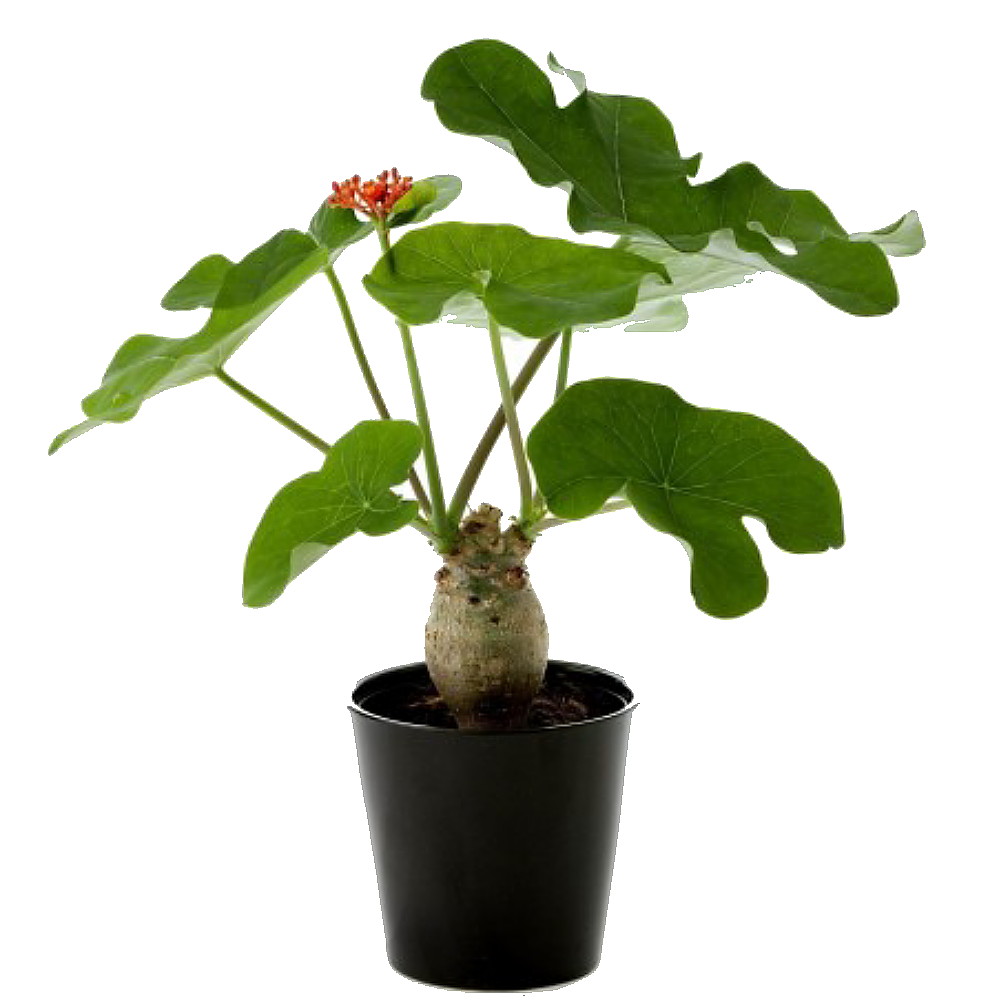Jatropha podagrica is a tropical plant, they are unique plants that received their name buddha belly because of their round shape, looks like swollen bellies. They are considered shrubs(bush plant), yet they’re toxic, so they must be handled with care. Buddha belly plants require the proper care to thrive in the environment they’re in. Though the Buddha belly plant attracts butterflies and hummingbirds, they won’t harm the plant.
Type :
1) Jatropha podagrica

Common name : Buddha belly, bottle plant
How to Plant : Buddha belly plants can grow from seeds, or take saplings from a plant nursery. If you love growing plants from scratch, start from seeds using method below. Put a seed into the soil container or seedling tray with the right amount of soil mix (A mixture of 1/3 - red soil, 1/3 - coco peat, 1/3 - compost, and some amount of perlite (50gm to be precise) or sand for better drainage) until it forms into a small plant, at which point, you will need to re-pot. Because plants need fresh soil every year to grow correctly.
Active growth period : The Buddha belly plant’s active growing seasons are spring and summer. In the fall, it begins to shed its leaves to prepare for winter, during which it lies dormant until the spring comes and the plant wakes up again.
Add a good amount of fertilizer (100 - 150 gm) once a month. Preferably use organic fertilizer like any type of compost (normal compost or vermicompost)
- since it is a flowering plant small amount of phosphate is also good fertilizer to use DAP granules. theaffordablestore, Granules link. Put minimal amount 4-5 granules per 15-20 days
Sunlight: Give it the proper light and temperature. A Buddha belly plant, if grown indoors, needs plenty of sunlight, although too much direct sunlight can be harmful to the plant’s leaves – it will burn them. Setting the Buddha belly plant near a south-facing window is good. This means that you need to rotate the plant often throughout the year and keep a close eye on the leaves to make sure they aren’t getting too hot.
Water : This plant need good amount of water as well, give water when the top half-inch of soil dries. Or add water twice a week, don’t overwater the plant.
Humidity : Since buddha belly is a tropical plant, it loves humid environment, but do not overwater it is harmful to roots, and possible fungal attack too.
Soil : The plant loves well-drained soil. Make soil mix with better drainage components. re-potting plant every year to a bigger pot at least 2 inches bigger than previous pot, which usually helps plants to grow bigger. This plant loves new soil and it will grow better. Tips - You can re-pot the plant any time once throughout the year, but try to re-pot just before its active growth period, it will help the plant to grow bigger leaves and a good amount of flowers.
Temprature : 23C to 40C is the best temperature condition. If the temperature rises put the plant inside a room for some days, in a bright, well lit environment.
Toxic : The Buddha belly plant is considered poisonous. Don’t touch the sap (transparent or semi-white liquid) and keep the plant away from small children and pets. If they consume the fruit, they can become very ill. Call Poison Control and seek medical attention immediately if you believe you’re experiencing symptoms from touching or consuming the plant.
Problems cause and solution :
SYMPTOM: Leaves turning brown and crispy at the edges, leaves small in size
CAUSE: Thirsty plant, underwatered
SOLUTION: Give water regularly and give a humid environment for thirsty plants.
——————————————–
SYMPTOM: Yellowing leaves to light brown to brown or black stems
CAUSE: Overwatered
SOLUTION: Re-potting and changing soil is the best option, if not possible put the plant outdoor and don’t water till the soil dries, also add some perlite and dry coco peat to the soil.
——————————————–
SYMPTOM: Mites attacks if it’s growing outdoors (white-colored insects or powdered leaves)
CAUSE: Very high humidity level in soil, watering late during the day.
SOLUTION: Do not overwater and avoid water plants after sunsets, because it creates a condition where insects grow faster.
- create a mixture of neem oil (4-5 drops) and liquid soap (4-5 drops) for half a liter of water and spray to all leaves and infected area twice a week till insects disappeared.
- clean leaves with fresh water before noon for a week.
——————————————–